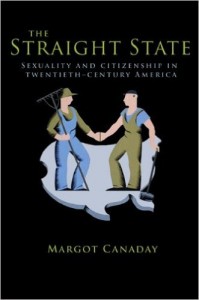 The Straight State: Sexuality and Citizenship in Twentieth-Century America
The Straight State: Sexuality and Citizenship in Twentieth-Century America
by Margot Canaday
Princeton. 296 pages, $29.95
MARGOT CANADAY’S The Straight State: Sexuality and Citizenship in Twentieth-Century America argues that the last century’s evolving perception of sexuality changed the concept of American citizenship. She pursues her thesis with a rigorous review of the archives to illuminate how federal policies were increasingly inflected with an awareness of non-normative sexualities. She argues that the preference for heterosexual citizens evolved alongside the rise of the modern American bureaucratic state. Her provocative discussion delineates how the state came to utilize immigration as surveillance, the draft as discipline, and welfare as domestication in the surveillance and regulation of sexual behavior.
It is Canaday’s contention that the state’s awareness of homosexuality gradually progressed from physical surveillance, in which bodies were examined for anatomical anomalies, to psychological examination, in which minds were probed for deviant desires. While Foucault argued that “the homosexual” emerged as a distinct social type in the late 19th century, Canaday’s research suggests that the modern American bureaucratic state had difficulty identifying the homosexual as a kind of person until quite a bit later: “Progressive-era officials used the word homosexuality somewhat interchangeably with ‘pervert,’ ‘degenerate,’ ‘pederast,’ and ‘sodomite.’” She also notes that during this era homosexuality was often typified through gender deviation rather than sex-object attraction.
The Straight State is divided into two parts: “Nascent Policing” and “Explicit Regulation.” Canaday traces the convergence of these ideas, as the state joins the policing of the gender invert with the regulation of sexual object choice to form something akin to the contemporary dualism of “gay” and “straight.” She breaks each of the two parts into three sections covering immigration, the military, and welfare.
In section one of “Nascent Policing,” she identifies how the state’s response to sexual variance in immigrants was meditated by policies designed to prevent the entry of something seen as a feature of European degeneracy: same-sex desire. Section two details how the methods for policing immigrants were extended to World War I draftees, challenging the assumption that this practice started with World War II. In the section on welfare, Canaday illustrates how post-World War I concerns with solider repatriation and transient able-bodied males conflated “the hobo with the homo,” resulting in heteronormative welfare policies. With this structure, Canaday demonstrates how three major areas of citizenship were progressively calibrated by mid-century to produce an awareness of the homosexual as a person to be restricted or denied full American citizenship.
In part two, “Explicit Regulation,” Canaday reverses the order of the sections and places the issue of national welfare at the heart of her discussion. Her signal argument is that by mid-century the modern bureaucratic state was explicitly organizing its policies and procedures around the assumptions of heteronormativity. Homophobia was not so much a response to the growing visibility of gays and lesbians as it was another progression in a longer process of constituting the modern American citizen. The state’s awareness of homosexuality had actually crystallized during the New Deal era, when the idea of the homosexual became a factor in the regulation of charity, conscription, and citizenship.
One of Canaday’s objectives, in her own words, is “to complicate what has now become a standard interpretation within the field of gay and lesbian history as well. Namely, that extreme state repression of sex and gender nonconformity in the mid-twentieth century was a result of the sudden visibility of gays and lesbians during and after World War II.” She largely achieves this goal, though her discussion might have benefited from an even longer view than the one she’s adopted. For example, she might have considered how the concept of citizenship was reconfigured by the doctrine of Manifest Destiny, which held important implications for the gender, sex, and sexual configuration of the modern American citizen. In addition, any discussion of sexuality and citizenship in the 20th century seems incomplete if it doesn’t grapple with the impact of AIDS upon policies for military recruitment, immigration, and welfare.
Mark John Isola, PhD, is assistant professor of English at the Wentworth Institute of Technology.






